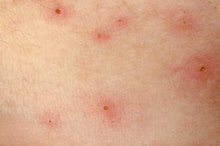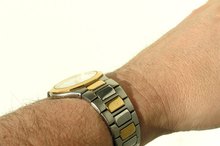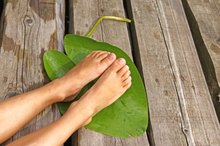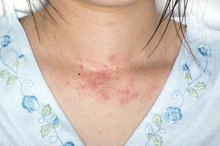What does fact checked mean?
At Healthfully, we strive to deliver objective content that is accurate and up-to-date. Our team periodically reviews articles in order to ensure content quality. The sources cited below consist of evidence from peer-reviewed journals, prominent medical organizations, academic associations, and government data.
The information contained on this site is for informational purposes only, and should not be used as a substitute for the advice of a professional health care provider. Please check with the appropriate physician regarding health questions and concerns. Although we strive to deliver accurate and up-to-date information, no guarantee to that effect is made.
What Are the Causes of Bruising From Scratching Dry Skin?
Bruises result from broken blood vessels that leak near the skin's surface, and can appear as black, blue, purple, yellow or green areas on the skin. Fortunately, bruising as a result of scratching dry skin is preventable and treatable through lifestyle changes and self-care.
Types
Bruises related to scratching might result from a medical condition, such as eczema, that caused the dry skin, or from personal behaviors, such as scratching too hard or frequently.
Features
AmLactin Lotion Side Effects
Learn More
Bruises from scratching dry skin might appear swollen, feel tender to the touch, appear as lines across the skin and occur all over the body.
Identification
Primary care physicians and dermatologists identify and diagnose the causes of bruising and dry skin. Patients might receive a physical exam and undergo blood tests for diagnosis of medical conditions that cause bruising and itching.
Considerations
How to Get Rid of a Bruise From Cellulitis
Learn More
Women, people who are elderly and those who take blood thinners such as aspirin are more likely to easily bruise after scratching dry skin.
Treatments
According to the Mayo Clinic, recommendations for treating bruises include elevating the affected area, applying cold packs several times daily and using a pain reliever such as acetaminophen 2.
Prevention/Solution
Using a daily moisturizer, avoiding prolonged exposure to sunlight and hot showers or baths, and wearing long sleeves and pants can protect the skin from bruises and reduce the urge to scratch.
Related Articles
References
- Mayo Clinic: Bruise First Aid
- Mayo Clinic: Easy Bruising
- McGarry GW. Recurrent epistaxis in children. BMJ Clin Evid. 2013;2013:0311.
- American Academy of Pediatrics, HealthyChildren. Bruises and cuts.
- American Academy of Pediatrics, HealthyChildren. How to stop a nosebleed. Updated September 30, 2019.
- Khair K, Liesner R. Bruising and bleeding in infants and children--a practical approach. Br J Haematol. 2006;133(3):221-31. doi:10.1111/j.1365-2141.2006.06016.x
- Nemours KidsHealth. Hemophilia. Updated February 2020.
- Nemours KidsHealth. Von Willebrand Disease. Updated July 2019.
- American Academy of Pediatrics, HealthyChildren. AAP offers guidance to pediatricians evaluating bruising or bleeding that is suspicious for abuse. Updated March 25, 2013.
- Nemours KidsHealth. Henoch-Schönlein Purpura (HSP). Updated June 2016.
- Centers for Disease Control and Prevention. What is vitamin K deficiency bleeding? Updated December 19, 2019.
- Hoffman R, Benz EJ, Silberstein LE, Heslop H, Weitz J, Anastasi J. Hematology: Basic Principles and Practice, 6th ed. Philadelphia, PA. Elsevier. 2013.
- Kliegman RM, Stanton B, St. Geme J, Schor NF. Nelson Textbook of Pediatrics, 20th ed. Philadelphia, PA. Elsevier. 2016.
- Yee DL. Causes of Thrombocytopenia in Children. In: UpToDate. Armsby C (ed). UpToDate. 2016.
Writer Bio
Jessica Lietz has been writing about health-related topics since 2009. She has several years of experience in genetics research, survey design, analysis and epidemiology, working on both infectious and chronic diseases. Lietz holds a Master of Public Health in epidemiology from The Ohio State University.









